This article was originally published in November 2013 and has been updated.
You must be competitors, right?
Great question — I had the same one when I first started at Keen IO! However, once you understand what we both do, the differences are clear. So, how about a crash course in what makes us both unique?
Mixpanel’s Event Data Collection in a Nutshell
Mixpanel is an end-to-end analytics software product, built primarily with marketers and product optimization in mind. What does that mean? It means they take care of everything (data collection, analysis, visualization, analytics insight) in a pre-defined form, so you don’t have to. You can easily track and optimize product usage and conversion rates. It’s also a fantastic out-of-the-box tool that is easy to use if you’re not a programmer. Pre-built dashboards can help guide users with different skill sets within your organization (even if they don’t yet know what they need to know), so they can derive intelligence from data and make products more engaging and more effective. Mixpanel does a great job providing analytics for a lot of companies doing things like segmentation, funnels, retention, user paths, etc. — features their customers love their product for.
Screenshot of funnel analysis in Mixpanel:
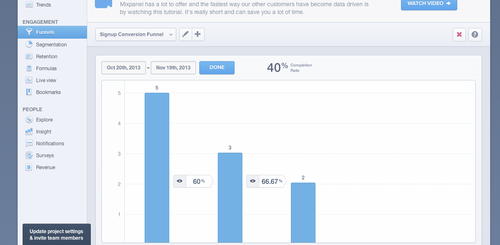
Keen IO Event Data Collection in a Different Nutshell
Keen IO is used in a much more raw fashion, as we don’t provide an end-product for marketers to use. Instead, we provide a fully managed REST API for doing analytics over schema-less event data. With our platform, developers build complex, hyper-custom, large-scale analytics and data science features directly into their web, mobile, or Internet of Things applications. Software teams use our platform to build analytics products or features for anyone they’d like, including marketers.
Although our API is used to collect event data in a similar way to Mixpanel, our customers typically require more customization and control over how that data is used: how it’s transferred, aggregated, embedded, and/or presented. Developers use Keen IO when they (or their companies) have specific business needs to work with their streams of event data programmatically, whether it be in raw form or aggregated in real-time. For example, they may want to integrate customized data science features, like data explorers, dashboards, or even the results of KPI’s in real-time, directly into a website, application, software service, or onto a TV screen in their office.
We do this by offering an API that provides building blocks for developers to collect their data, then analyze and present insightful customized views of this data. For example, funnel analysis can be done in a number of ways.
Want to run your own funnel analysis by using our analysis API and charting library in JavaScript?
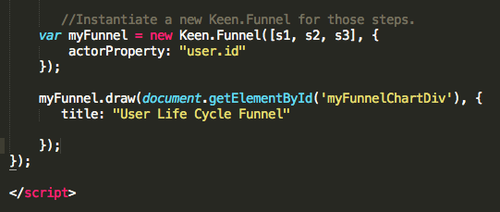
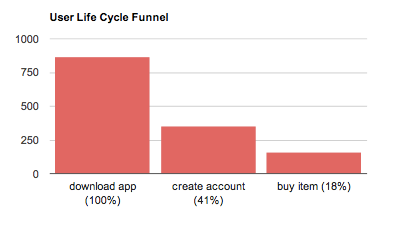
You can also use Keen to run analyses like funnels, programmatically, using one of our many SDKs such as python:
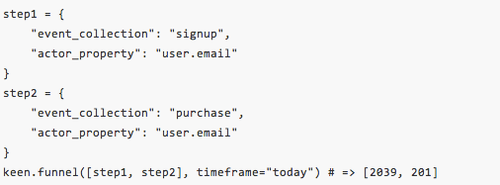
or Ruby:

Many of our customers work directly with our analysis API, and plug the query results into a custom charting library. This custom dashboard (built by one of our customers) shows their customers the success of their email campaigns. Check out the funnel analysis…
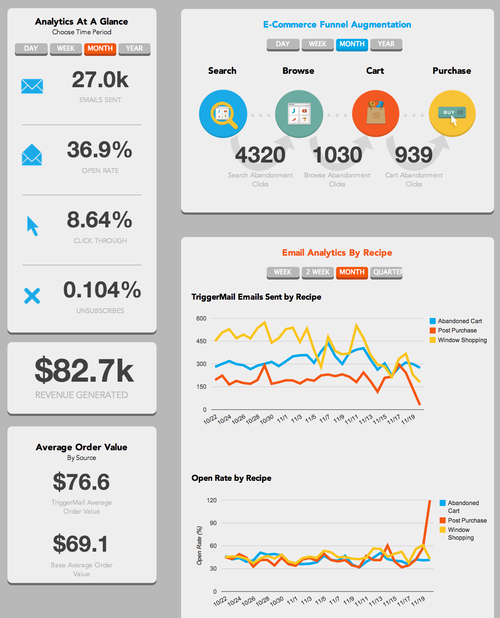
Where’s the Overlap?
Mixpanel and Keen IO both offer analytics tools, of course, and we both do so by collecting “events” (clicks, swipes, purchases, page-views, sign-ups, sword-deaths, level-ups, etc.) in real-time that happen on a website, app, smart device, etc. The data collection side of our stories are actually fairly similar.
Screenshot from adding events via our Javascript SDK :
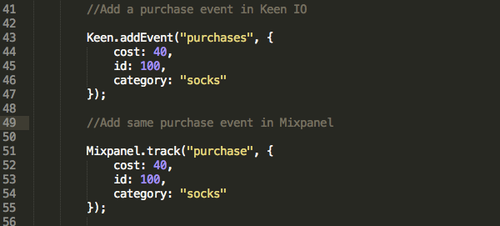
We Built Our API to Empower Developers to Build What They Need:
More often than not, there are problems beyond the ones you can solve with an off-the-shelf product. If your problem is beyond the scope of something off the shelf, the DIY approach is the only way to solve your problem. If you’re going to DIY, you can choose between building from scratch or building on a fully managed service like our API.
Keen IO is focused on being a platform in the purest sense, so that developers can integrate analytics into the functionality or features of anything they build.
What Are Some Examples of Keen IO in the Wild?
- A growth hacker writes a script to send a nightly stats email on detailed actions users take in his app;
- An enterprise SaaS company provides analytics within their customer portals for their customers to track and optimize their own stats;
- A software team replaces their in-house event data backend, which was having problems scaling, with our cloud API
- A gaming company provides metrics in their gaming platform to help developers track the performance of their games;
- That same gaming company also builds separate dashboards aggregating data across all of their users, so they can optimize the use of the product and revenue;
- An e-commerce site optimizes ads and products that are served dynamically based on a given user’s behavior on their site;
- An AdTech company builds a custom advertising data dashboard for their sales team that correlates successfully converted ads with viewer attributes — they can sell more relevant advertising
When Does an Engineering Team Typically Consider Using an API Like Keen IO?
Building a custom analytics infrastructure that scales requires significant focus of time and energy from an engineering team with a very specific skill-set. Many of our customers have approached us after they’d searched the market and then planned to build a solution to meet their custom requirements. They typically consider Keen IO when the resources of building and maintaining analytics at scale from scratch draw significant opportunity costs on a bandwidth-limited team’s core focus, and they are looking for the leverage of an API.
For some real-world examples of the sort of problems Keen IO has helped to solve, check out our case studies:
https://keen.io/story/active_prospect
https://keen.io/story/active_prospect
https://keen.io/story/active_prospect
If you’d like to play around with Keen IO for yourself, you can request a demo today! Just let us know if you have any questions.
Hopefully by now, the differences are distinct. As a disclaimer, we of course can’t speak on behalf of Mixpanel, or their product roadmap; both of our products are evolving over time. If you’d like to learn more about how this applies to your specific company, software or problems, feel free to send us a note explaining what you’re looking to do and we’ll be happy to point you in whichever direction we think will work best for your needs, be it Mixpanel, Keen IO or something else.




